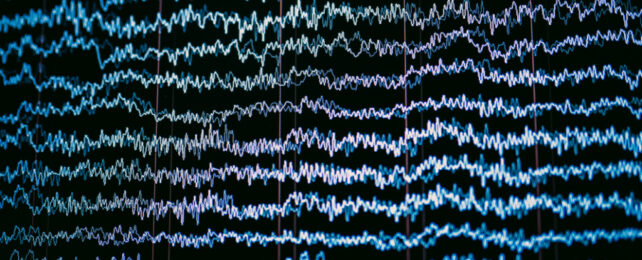Depression is a stubborn beast that all too often refuses to budge with treatment. When all else has failed, sometimes electroconvulsive therapy (ECT) can work – but after almost a century, we don't really know how.
Now, new research has identified a possible explanation for ECT's mechanism buried in the brain's background noise. According to the team behind the studies, their work helps "demystify one of the most effective, yet stigmatized treatments for severe depression."
ECT hasn't shaken off its controversial past despite being up to 80 percent effective in alleviating the symptoms of depression, bipolar, and schizophrenia when antidepressants and other therapies have failed.
The therapy involves the delivery of controlled pulses of electricity to a person's brain while they are under general anesthetic. As effective as ECT may be for some patients, there are major downsides, including temporary confusion and memory loss.
"Understanding how [ECT] works will help us discover ways to increase the benefits while minimizing side effects," says Bradley Voytek, a cognitive scientist at the University of California (UC) San Diego who co-authored the two new studies about ECT.
Whether it be ECT, antidepressants, or psychedelics, a common thread between these treatments is that they are thought to somehow loosen the brain from the grip of depression by 'resetting' brain circuits or changing its structure.
In 2015, researchers at UC Los Angeles scanned the brains of people receiving ECT and found in some patients the treatment reshaped neural connections in two specific brain regions; the amygdala and hippocampus.
This new study offers a different take, suggesting the treatment could instead restore a more ubiquitious function related to a long-neglected phenemonon called aperiodic activity.
Led by Sydney Smith, a neuroscience graduate student in Voytek's lab at UC San Diego, the first study looked at patterns of brain activity in nine patients with major depression disorder as they underwent 12 sessions of ECT.
The researchers found something in the data that may explain the 'slowing' of brain waves observed on electroencephalography (EEG) read-outs of brain activity days on or even weeks after ECT. The link between this slowing and ECT's antidepressant effects is disputed, but still intriguing.
So the team analyzed EEG signals after ECT sessions and found a "striking" increase in aperiodic activity, a type of electrical activity in the brain that doesn't follow a consistent pattern like other brain waves.
"Aperiodic activity is like the brain's background noise, and for years scientists treated it that way and didn't pay much attention to it," explains Smith.
More recently, however, with software developed by Voytek's lab to separate out rhythmic brain waves from the brain's background noise, scientists have started thinking aperiodic activity may help regulate brain function by boosting cortical inhibition, which in theory may be reduced in MDD.
"We think electroconvulsive therapy helps restore this function in people with depression," Smith says.
Aperiodic activity continued to increase with multiple ECT sessions, however there was no control group in the study to see what effect ECT had in healthy people.
In a second study led by Smith, researchers compared ECT to another depression treatment called magnetic seizure therapy (MST) which uses focused magnetic fields instead of electrical pulses to stimulate the brain.
Much work has been done to test variations of ECT to reduce side effects without compromising the therapy's antidepressant effects. In a similar vein, MST was developed as a cognition-sparing alternative to ECT.
Indeed, a 2021 meta-analysis showed MST is as effective as ECT, yet patients treated with MST recover quicker and have fewer memory troubles than those who undergo ECT.
Analyzing data on 22 patients from previously published MST studies and 22 other patients from previously published ECT studies, the UC San Diego team found that aperiodic activity increased in both ECT and MST patients, which suggests the two forms of therapy could be having similar effects in the brain.
Without control groups, it's hard to say with confidence that this change in the brain's background hum is a direct result of either treatment. Being small and exploratory, the studies can only hint at a possible mechanism for ECT's effectiveness. It will take a lot more research to dislodge existing theories about how the therapy works.
Given the erratic nature of this aperiodic brain activity, which has only come to the fore in the last few years, scientists are also still unsure what physiological processes give rise to aperiodic signals.
And so, with one answer about how ECT possibly clears the haze of depression, the mystery of its underpinnings deepens.
The papers have been published in Translational Psychiatry here and here.
